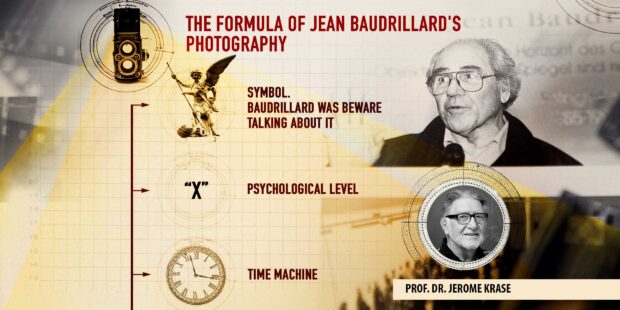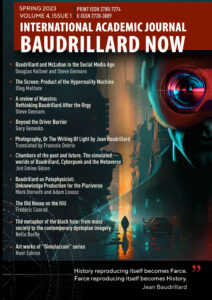
Innermost depths of Baudrillard’s legacy in the book of Dr. Oleg Maltsev.
Review of Maestro. The Last Prophet of Europe
By Prof. Dr. Jerome Krase
At the onset, I must apologize for what will be a rather unconventional review of an unusual book about an unconventional, or perhaps better said, hyper-unconventional thinker – Jean Baudrillard. Maestro: The Last Prophet of Europe by Oleg Maltsev is an intellectually challenging sixteen-chapter book, and given my rather passing familiarity with Baudrillard’s oeuvre, it was not what I expected. However, similar to my too many encounters with Umberto Ecco’s “fiction,” I was intrigued at first, and then delighted with the challenge. Maltsev discovered in the Maestro’s work much more than other readers, such as myself have, at least up until this point. It is those uncovered/discovered nooks and crannies that were most important, and for that I am grateful for the unexpected hyper-enlightenment. Maltsev, gingerly places Baudrillard amidst, but not among, the many French theorists such as Jacques Derrida and others usually placed within the contemporary poststructual / postmodernist / postcritical / posteverythingelse pantheon that continues to haunt prepostmodernists, like myself, in the social sciences and humanities.
In his richly illustrated text, Maltsev presents a reasonable (if that is the right word) argument for a Baudrillardian unified philosophy; something that Jean himself might find a bit “out there.” Most readers of Baudrilliard have most frequently seen his fifty-odd works, that Maltsev deftly synthesizes, as a jumble of discrete jigsaw puzzle pieces that might, with great mental effort, be fit together into a single image. Allow me here a bit of a Baudrilliardian quip in that there might be many, completely different, images assembled from these jumbled pieces. Maltsev assembles his work into what he feels is a coherent system. Having not read most of the works to which he refers, I can’t judge the system’s reliability or validity, but the argument he makes, as enhanced by the visual logic of many supporting images, is quite convincing and, as intended, has practical value for a wide range of scholars. I should also note here that creating coherent systems from varied data is a distinctly “modernist” project. However, as he intended, it helps to increase its practical value in the philosophy of science, psychology, psychoanalysis, and sociology which are dependent on simpler paradigms.
Although an adequate refining of the rich ore from Maltsev’s deep mining is beyond both my ken and the scope of this necessarily brief review, I must touch upon those that have the most valuable for my continuing research and writing about “seeing “urban lives and cultures. For example, having been on many of my own photographic expeditions to Southern Italy and having been greatly informed by the description and analysis of its opaque political culture by the well-known urban anthropologist Italo Pardo (2003), Maltsev’s allusion to Southern Italian philosophy as a resolution Baudrillard’s paradoxical claim that because the masses cannot invent anything, therefore they synthesize everything warrants close attention.
“Today the values are democratic. This implies an insoluble contradiction at the level of “services”, the practice of which is irreconcilable with the formal equality of people. The only way out is to spread the social Game (for today everyone is forced to receive and provide services, not only in private life, but also in their public and professional practice — everyone is more or less “tertiary” in relation to the other). The social game of human relations in a bureaucratic society is different from the terrible hypocrisy of Swift’s servants. It is a gigantic model of “simulation” of absent reciprocity. It is not stealthy, but functional simulation. The minimum life of social communication is achieved only at the cost of this relationalist training in which everyone is included — a magnificent optical illusion designed to mask the objective attitude of alienation and distance directed from everyone to everyone. “(Baudrillard, J. (1998). The Consumer Society: Myths and Structures)
However, while people appear to be forced to “support” each other, creating the synthesis, according to Maltsev, Baudrillard’s philosophy paradoxically argues that a person still can choose.
As a visually-oriented social scientists I was especially appreciative of Maltsev’s chapter, “Baudrillard’s Photography”. As he explains it, his acquaintance with Baudrillard began with his philosophy and subsequently discovered that Baudrillard’s photography was a mirror-reflection of his theory about simulation and simulacra which emerged during Baudrillard’s visit to America. It seems that while photographing the desert, Baudrillard unexpectedly came across mirages that, as optical illusions, demanded explanation (or meaning) beyond the visual data. As Maltsev relates:
“… in this aspect, I relate to Baudrillard a lot; for me, as a scientist, a camera is also a research tool, not simply an illustrator. The photos I make are incomprehensible sometimes, as is the question of why I took them in the first place. But I see in those images things that others don’t. Back in time, “watching” and “seeing” meant very different things and people were aware of this difference. As chairman of one of the oldest scientific photographic societies globally, the Odessa Photographic Society, and as a head of the Expeditionary Corps (a special unit of the Memory Institute) I take a lot of photographs in different parts of the world under different circumstances and conditions. If all my photographic work made in expeditions in different countries is looked at, then half of them are not artistic at all, but aimed at assisting research.” (202)

I was first introduced to Baudrillard’s ideas while working on a book, Seeing Cities Change: Local culture and Class (2012) that I intended to be the capstone of my visual studies of urban neighborhood communities. I must also note here that my introduction to Maltsev’s work is more direct and less relevant for the current review. Some time ago, we had a long conversation about Baudrillard. (Krase 2021 ) In that conversation, I reflected on how even the vaguest understanding of his work impacted on the practice of urban ethnography, especially in this growing practice of digital-related other related multimodal ethnography in which it is almost impossible to distinguish among visual and other simulacra.
To conclude this review, I should share some words on Maltsev’s final chapter “A Composite Conceptual Model Of Baudrillard’s Philosophy” in which he attempts to sketch his philosophy with the help of what he claims is a “simplified,” model “which will be easy to grasp” consisting of three parts:
1) The world we live in;
2) A prism (or screen) through which we look at this world;
3) Unexplained mystical phenomena. (253)
Only a basic understanding of Baudrillard’s work is needed to grasp the first two parts, but the last requires a much closer reading, as Maltsev, via both physical and mental expeditions, (re)connects European mysticism and ancient science to both (modern) abstract philosophy and empirical science, as he concludes;
“The outstanding philosopher of the twentieth century, Jean Baudrillard in his writings, clearly described not only what is happening in the world today, but also gave very precise reasons for why everything is so, and not otherwise; how the modern world has formed, and what awaits humanity if nothing changes. His philosophy is extremely practical but only for those who want to understand it and apply it in their lives. And the choice, as Baudrillard himself noted, is up to every human being himself. On this note and at this stage of scientific work, I have the honor to bid you farewell, dear reader!” (266)
After reading Maltsev’s rendition (perhaps construction is the better term) of The Maestro, for me, Baudrillard seems to be saying that one cannot make “common” sense out of the manipulated worlds in which we live, but only either accept it and pretend it is real or try to lift the many veils that hide the phenomenon from actual view. Like Maltsev, I prefer the latter.
PS: I would be remiss if I did not commend the excellent Preface “Why Baudrillard, Why Now” by Andrew McLaverty-Robinson which pointed me in the best direction for appreciating, if not apprehending, Oleg Maltsev’s Maestro.
References
Krase, Jerome. 2012. Seeing Cities Change: Local Culture and Class. London: Routledge
Krase, Jerome. 2021. “Jean Baudrillard, Me, and Ethnic Theme Parks,” Baudrillard Now, 2(1), (First OnLine: November 8, 2020). https://www.baudrillard-scijournal.com/jean-baudrillard-me-and-ethnic-theme-parks-by-jerome-krase/
Pardo, Italo. 2003. Managing Existence in Naples. Cambridge University Press.
Discover more from BAUDRILLARD NOW
Subscribe to get the latest posts sent to your email.


